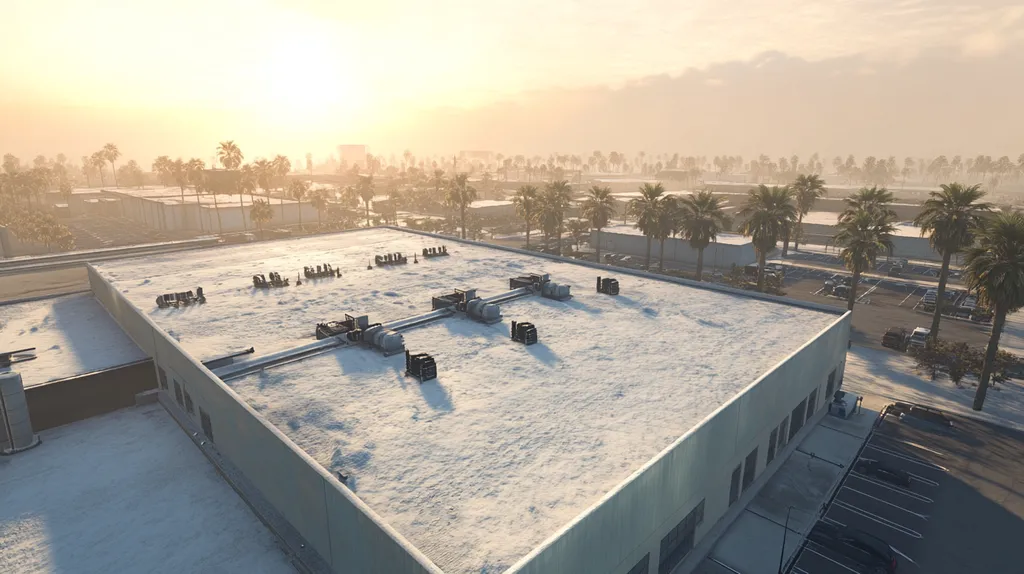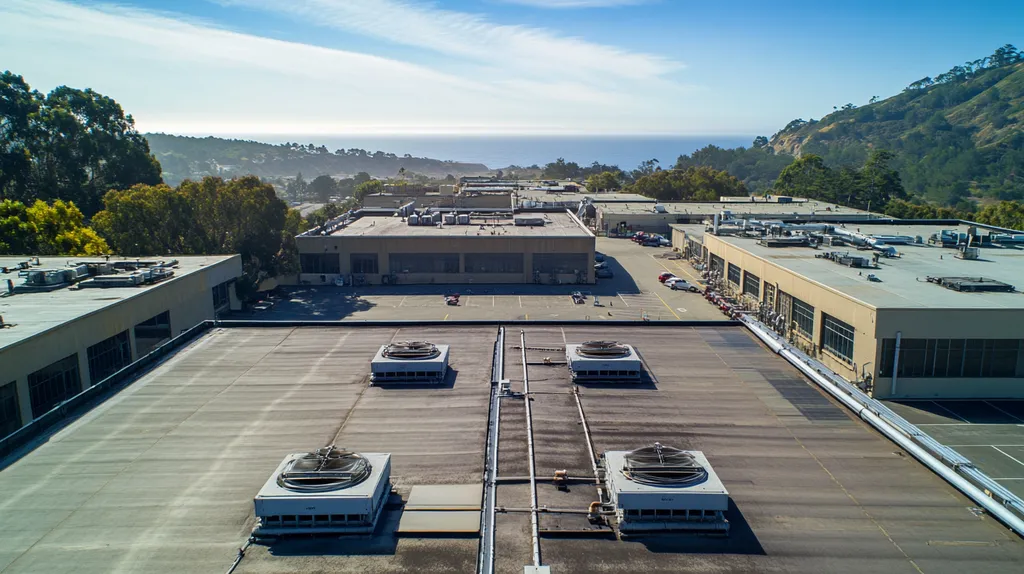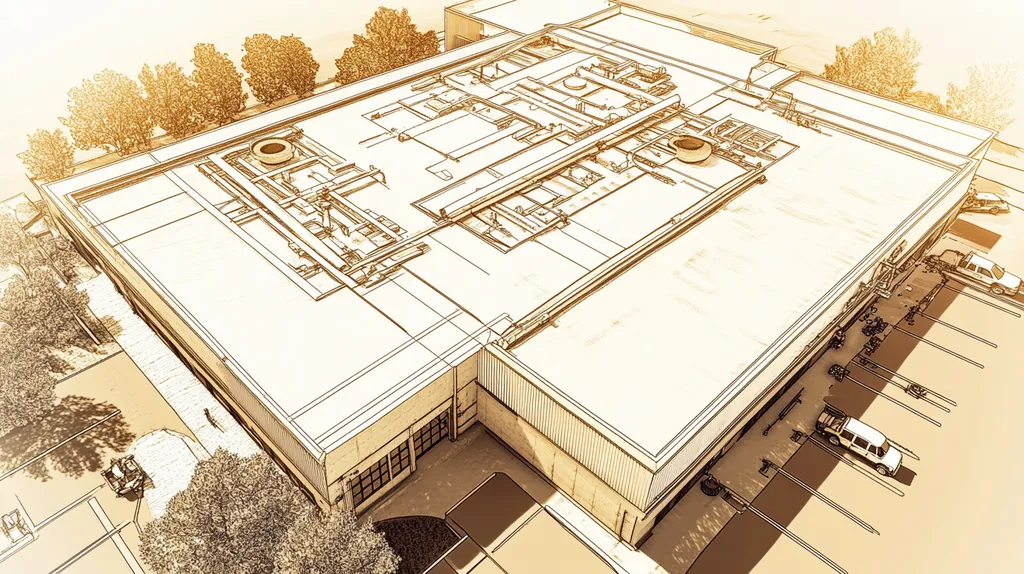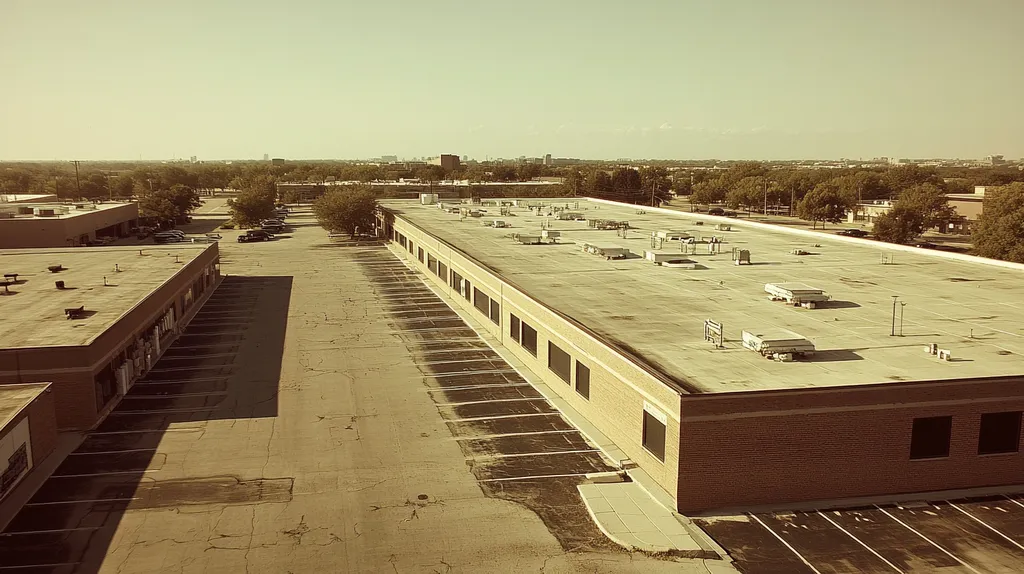Commercial roofing warranties represent a $12 billion annual investment across North America, yet studies indicate that over 70% of property owners misunderstand or mismanage their coverage, leading to denied claims and costly repairs.
The traditional approach to warranty management, characterized by reactive maintenance and poor documentation, continues to strain facility budgets and compromise building integrity.
This analysis examines systemic failures in current warranty practices while presenting data-driven solutions for property owners and facility managers to maximize their roofing investments through enhanced inspection protocols, manufacturer collaboration, and technology integration.
SECTION 1: CURRENT PRACTICES
The commercial roofing landscape presents significant challenges, particularly concerning warranties. For property owners and facility managers, making informed decisions about warranty options can be crucial, as it can mean the difference between facing costly repairs and enjoying long-term protection. Given the substantial financial commitments involved, understanding the various types of warranties, their durations, and necessary maintenance requirements is essential for maximizing investments in roofing systems.
Types of Commercial Roof Warranties
Commercial roof warranties generally fall into two primary categories: manufacturer warranties and contractor warranties. Manufacturer warranties provide assurances against material defects and poor workmanship, protecting property owners from premature roof failure. However, it is crucial to recognize these warranties can differ widely based on the manufacturer’s reputation and the specifics of the materials used.
On the other hand, contractor warranties safeguard the quality of the installation work itself. These warranties can span from a single year to as much as two decades, reflecting the contractor’s service quality. Property owners are encouraged to examine both types of warranties thoroughly, focusing on their specific terms and exclusions to find the best coverage for their unique situations.
Some providers also offer bundled warranties that combine both manufacturer and contractor coverage. While these options may seem attractive, they can also carry additional costs and conditions. Careful evaluation is necessary to ensure that the benefits justify any extra expenditures, thereby preventing unanticipated future expenses.
Ultimately, comprehending the nuances of different warranty types is vital for making informed roofing decisions. Without this knowledge, property owners risk selecting warranties that do not adequately protect their investments.
Warranty Duration and Coverage
The length of a commercial roof warranty significantly impacts its effectiveness. Standard warranty durations typically range from 10 to 30 years. However, property owners should be cautious; a longer warranty does not necessarily guarantee superior protection. Certain warranties come with limitations that could diminish their value over time.
It is crucial to understand the specific coverage details of each warranty. While many warranties do cover leaks, they often exclude damages resulting from natural disasters or inadequate maintenance. This lack of clarity can lead to coverage gaps, leaving property owners vulnerable to unexpected repair costs, especially when their roofs encounter issues.
Evaluating the long-term implications of warranty duration is also essential. Though shorter warranties may appear more financially appealing due to lower initial costs, they can lead to higher expenses in the long run if roof problems arise. A robust warranty, while requiring a greater upfront investment, can lead to significantly lower repair costs over time.
Additionally, property owners should note that some warranties are transferable, which can enhance the property’s marketability when it comes time to sell. This characteristic can positively affect overall property value, making it a vital factor to consider in the decision-making process.
Maintenance Requirements
Most commercial roof warranties come with stringent maintenance requirements that can significantly impact their validity. Manufacturers often mandate regular inspections and maintenance to ensure warranty coverage remains intact. Failing to meet these conditions can result in voiding the warranty, leaving property owners exposed to unforeseen financial liabilities.
Conducting regular maintenance is essential not only for preserving warranty protections but also for extending the lifespan of the roof itself. Poorly maintained roofs are prone to severe issues, such as ponding water and leaks, which can escalate into costly repairs if not promptly addressed. Adhering to scheduled maintenance is crucial for warranty claims to be honored.
Moreover, property owners should obtain documentation from contractors to verify that maintenance has been performed as required. Keeping thorough records serves as vital evidence should a warranty claim become necessary.
Investing time and resources into understanding and complying with warranty maintenance requirements is not just prudent; it is a critical step in safeguarding significant capital investments in commercial roofing.
SECTION 2: SYSTEMIC ISSUES
The commercial roofing industry faces significant challenges that jeopardize effective warranty management. Alarmingly, 70% of property owners do not fully understand the coverage details of their roofing warranties. This lack of awareness can result in costly repairs or, in some cases, the premature failure of roof systems. Addressing limitations in material and labor coverage, recognizing the risks of voiding warranties through neglect, and identifying gaps in weather protection are essential for sound warranty management.
Limitations in Material and Labor Coverage
Many roofing warranties come with specific limitations that are easily overlooked. Commercial property owners might assume their warranties cover all aspects of their roofing systems. However, exclusions regarding certain materials or installation processes can create significant financial gaps.
For example, several warranties provide coverage for defects in materials but do not cover the associated labor costs for repairs. Consequently, if a material defect arises, property owners may still face unexpected labor expenses.
Furthermore, time-limited guarantees for installation workmanship can lead to frustration. If a roofing issue develops just after the warranty period ends, all financial responsibility transfers to the property owner.
Thoroughly understanding these limitations is critical for informed decision-making. Property owners should carefully scrutinize warranty documentation and seek clarification to ensure they have comprehensive coverage.
Voiding Warranty Through Neglect or Non-Compliance
It’s common for property owners to inadvertently void their roofing warranties due to neglect or failure to comply with maintenance requirements. Roofing manufacturers often outline that regular inspections and upkeep are essential to keeping warranties valid.
If a roof is not maintained on a routine basis, future warranty claims may be denied. For instance, neglecting to clear debris or address minor leaks promptly can lead to substantial, unauthorized repairs that fall outside warranty protection.
Education on maintenance standards is vital. Property owners should collaborate with roofing professionals to establish a maintenance plan that not only meets warranty requirements but also extends the lifespan of the roof.
Unattended maintenance has broader implications. The cumulative effects of deferred care not only shorten roof longevity but can also drive up energy costs, affecting the building’s overall operational efficiency.
Gaps in Weather and Interior Damage Protection
Significant concerns exist regarding gaps in weather-related and interior damage protection in roofing warranties. Numerous warranties exclude coverage for specific weather events, potentially exposing properties to financial risks. For instance, common perils like hail damage may not be included, prompting property owners to seek supplemental insurance for sufficient protection.
Moreover, while exterior roofing concerns often dominate discussions, damage to interior spaces is frequently neglected. Water infiltration from a failing roof can cause serious structural harm, lead to mold growth, and necessitate costly repairs inside the building.
This commonly overlooked aspect of roofing warranties can carry severe financial consequences. Property owners must fully understand the scope of their warranties and consider additional coverage options to mitigate potential weather-related risks.
Taking proactive measures to address these gaps can save property owners both time and money while ensuring complete protection for the roof and the interior of the building.
SECTION 3: MISSED OPPORTUNITIES
Effective management of commercial roofing warranties is not just an option; it is a necessity with significant financial implications. Research highlights that improper maintenance and neglecting scheduled inspections can lead to premature roof failure, costing owners tens of thousands in unexpected repairs. Property owners and facility managers often overlook key components, such as regular inspections, strict adherence to manufacturer specifications, and the true costs associated with routine maintenance. These oversights can jeopardize warranty validity and ultimately compromise roof performance.
Overlooking Regular Inspections and Documentation
Regular inspections are a critical element often sidelined in warranty management. Skipping this essential practice can allow minor damage to escalate into major issues, often unnoticed until it becomes too late. Roofs subject to water pooling or punctures may hide significant problems until catastrophic failure occurs.
Systematic documentation during inspections is vital. Keeping detailed records can support claims if deterioration arises, as evidence is often required to substantiate warranty claims. Furthermore, following inspection schedules aligned with manufacturer recommendations ensures compliance with warranty terms.
Proactive inspections can detect potential problems early. For instance, regular assessments of roof membranes can identify small leaks before they escalate. This consistent documentation not only aids in managing warranties but also fosters a culture of preventive maintenance.
In summary, neglecting regular inspections and documentation can severely compromise warranty protections, ultimately resulting in higher costs than the expense of proper, proactive maintenance.
Ignoring Manufacturer Specifications
Manufacturers provide specific guidelines for the installation and upkeep of roofing systems. Disregarding these guidelines can have serious repercussions, including voided warranties. Each roofing system has unique requirements, and failing to adhere to these can lead to disastrous outcomes.
For example, using non-approved materials during repairs can seriously compromise the roof’s integrity. While property owners may believe they are cutting costs, they risk forfeiting warranty protections. Manufacturers often delineate the materials and methods necessary for proper maintenance, and neglecting to follow them can lead to costly repairs and potential litigation.
Additionally, maintenance approaches not aligned with manufacturer specifications can precipitate premature roof aging or failure, which may nullify warranty coverage. Regular training for maintenance personnel can be instrumental in ensuring compliance with these guidelines.
In conclusion, disregarding manufacturer specifications presents significant risks to both roof performance and warranty validity, potentially leading to increased operational costs and unanticipated liabilities.
Failing to Address Routine Maintenance Costs
Many property owners underestimate the role of routine maintenance in maintaining roof warranties. The immediate savings from neglecting regular upkeep can quickly dissipate when unexpected repairs arise from deferred maintenance. While routine maintenance may appear to be an additional cost, it is a vital investment that extends the lifespan of the roof.
For instance, regular gutter cleaning prevents water overflow and minimizes the risk of leaks. By addressing these minor issues before they escalate, property owners can avert significant future expenses. Failing to budget for routine maintenance can result in severe financial ramifications over time.
Moreover, recognizing the total cost of ownership includes these maintenance expenses as part of a comprehensive warranty management strategy. Integrating maintenance into the budget ensures that property managers prioritize the longevity and integrity of the roofing system.
Ultimately, neglecting routine maintenance may appear inconsequential, but the long-term costs associated with increased repair needs and diminished warranty protections can result in considerable economic strain.
SECTION 4: ROOT CAUSES
Effective warranty management in commercial roofing is critically undermined by several foundational issues. If not addressed, property owners may encounter heightened costs and diminished asset value. Alarmingly, improper warranty claims lead to more than $1 billion in lost funds annually across the industry. This section identifies key root causes—communication gaps, inadequate training, and budget obstacles—that contribute significantly to these challenges.
Lack of Clear Communication Between Manufacturers and Contractors
Communication breakdowns between manufacturers and contractors often result in major misunderstandings. These miscommunications can cause improper installations that void warranties and result in costly repairs. Furthermore, differing interpretations of warranty clauses can leave property owners exposed to unanticipated expenses.
When contractors fail to grasp the complexities of warranties, they may unintentionally overlook critical installation requirements. For example, certain warranties mandate specific temperature conditions for installation; ignoring this stipulation can lead to voided coverage. This can create frustration for property owners who assume they have adequate protection when they do not.
Inadequate documentation regarding methods and materials can further complicate warranty claims. Ambiguous guidelines may lead contractors to use unsuitable materials that fail to meet industry standards. Consequently, warranty claims can be denied, resulting in protracted disputes and significant costs for property owners.
Lastly, maintaining open lines of communication throughout the lifespan of the roofing system is essential. Regular updates and check-ins between contractors and manufacturers ensure alignment on maintenance needs and repair recommendations, safeguarding both the integrity of the warranty and the roof’s performance.
Inadequate Training for Maintenance Personnel
Well-trained maintenance personnel are vital to the longevity of roofing systems. Unfortunately, many property owners do not provide adequate training for their maintenance teams, jeopardizing warranty compliance. Without proper instruction, maintenance staff may employ incorrect practices that undermine warranties.
A common issue is personnel not being familiar with the specific care requirements of different roofing materials. For example, a lack of expertise in recognizing early signs of wear can allow minor issues to develop into significant problems. Additionally, maintenance activities that deviate from warranty terms can inadvertently occur due to inadequate training.
The multilayered nature of warranties can further overwhelm maintenance teams. Many lack a comprehensive understanding of warranty language and provisions, which can lead to missed opportunities for coverage during necessary repairs. Such oversights may result in unexpected costs and wasted resources for property owners.
Regular training sessions and certification programs can greatly benefit maintenance crews. Equipping teams with knowledge about current roofing technologies and best practices enhances the durability of roofs. Improved familiarity can also foster better communication with contractors and manufacturers.
Insufficient Budget Allocation for Preventative Maintenance
Preventative maintenance should be viewed as a vital investment, rather than an optional expense. Failing to allocate budget for routine upkeep can lead to significant long-term costs impacting property owners. A lack of funds for inspections and maintenance may result in premature roof failures and reduced warranty validity.
Many businesses do not prioritize setting aside resources for preventative care. Regular roof inspections can help identify potential issues before they escalate, while neglecting such checks can lead to substantial damage that may fall outside warranty coverage, ultimately costing more to repair.
Furthermore, property owners often chase short-term savings at the expense of long-term investments. This narrow focus can compromise the overall integrity of the roofing system. A strategic budget plan for maintenance allows timely interventions, helping save money while preserving warranty protections.
Educating key stakeholders on the importance of preventative maintenance can also improve budget allocations. Demonstrating the cost-effectiveness of regular roofing care can help secure necessary funding. In summary, a proactive maintenance strategy not only enhances roof performance but also reinforces associated warranties.
DATA DRIVEN EVIDENCE
The financial stakes in managing commercial roofing warranties are substantial, with warranty claims resulting in billions of dollars lost each year. The National Roofing Contractors Association (NRCA) reports that over 60% of warranty claims are denied due to improper installation or lack of maintenance. These statistics underscore the urgent need for effective warranty management practices. This section will delve into key data trends, highlight significant case studies, and compare industry best practices to identify areas for improvement in the field.
Statistical Analysis of Warranty Claims and Outcomes
Recent studies indicate that nearly 70% of property owners experience issues covered by warranties within the first decade. Alarmingly, only one-third of those claims are approved, often due to inadequate documentation or failure to comply with maintenance guidelines. This highlights a critical disconnect between installation expectations and actual practices, urging owners to fully understand their responsibilities.
Furthermore, roofs installed without a proactive maintenance strategy boast a staggeringly low claim approval rate of just 20%. This statistic emphasizes the need for robust planning and ongoing management. Regular maintenance is essential; by committing to it, property owners can dramatically enhance their prospects for obtaining timely claim approvals.
Additionally, data shows that roofs maintained in accordance with manufacturer guidelines enjoy a 50% higher likelihood of claim acceptance. This reinforces the importance of diligent adherence to warranty standards, showcasing that meticulous monitoring and thorough documentation significantly improve outcomes for property owners.
In conclusion, this statistical analysis makes it clear that proactive management and awareness of warranty obligations are crucial for financial stability. Denied claims can strain budgets, making it imperative for facility managers to prioritize this aspect seriously.
Case Studies of Successful and Failed Warranty Management
A notable case involving a prominent industrial facility exemplifies effective warranty management. After experiencing a significant leak five years post-installation, comprehensive documentation of repair and maintenance led to a successful warranty claim. This underscores the critical importance of maintaining detailed records to support claims.
In contrast, a retail chain experienced substantial financial losses when claims were denied due to poor documentation of scheduled maintenance. This oversight forced the company to shoulder extensive repair costs, illustrating the dire consequences of negligence in warranty management.
Conversely, a mid-sized company adhering closely to best practices managed to receive full reimbursements for two separate roof replacements. Their methodical approach included regular inspections and meticulous logging of activities, which impressed the warranty provider. This scenario highlights the potential benefits of diligent management and the trusting relationships it can foster with manufacturers.
These case studies not only serve as cautionary tales but also provide blueprints for success. They present compelling evidence that conscientious management strategies can significantly influence warranty outcomes.
Industry Standards and Best Practices Comparison
A comparison of industry standards reveals glaring inconsistencies in warranty management across various companies. While many roofing firms advocate for regular maintenance schedules, a considerable percentage fail to implement them adequately.
Best practices dictate that property owners engage in frequent inspections and closely follow manufacturer guidelines. However, many facilities fail to do so, resulting in elevated warranty claim denial rates. Those that strictly adhere to best practices report significantly higher success rates in claims, highlighting the importance of aligning with industry recommendations.
Moreover, record-keeping practices vary widely among facilities. Only 45% maintain proper documentation of repairs and inspections, whereas those with rigorous records enjoy much higher claim approval rates. This stark contrast emphasizes the critical role that thorough documentation plays in effective warranty management.
In summary, embracing industry best practices can substantially reduce the risks associated with warranties. Property owners and managers must grasp the significance of adhering to standards to navigate the complexities of commercial roofing warranties successfully.
SECTION 6: ALTERNATIVE SOLUTIONS
The urgency for effective warranty management in commercial roofing cannot be understated. Property owners face severe financial risks due to unnoticed roof issues, which often worsen over time. Alarmingly, over 25% of roofs develop leaks within the first five years, leading to expensive repairs and a reduction in asset value. To combat these risks, implementing alternative solutions can enhance the longevity and performance of roofing investments.
Implementing Comprehensive Inspection Schedules
Establishing a robust inspection schedule is vital for upkeeping commercial roofs. Routine inspections can uncover minor issues before they develop into major problems, significantly reducing the need for costly repairs. Experts advocate for biannual inspections, especially in areas subject to extreme weather disruptions.
An efficient inspection schedule facilitates early detection of vulnerabilities, such as loose membranes or compromised flashing. Addressing these issues promptly not only enhances the roof’s integrity but also extends its operational lifespan. Without such schedules, property owners may remain unaware of preventable issues until significant damage occurs.
Moreover, a systematic inspection program improves warranty management. Many warranty agreements require regular maintenance checks, compliance with which safeguards against claim denials. This proactive strategy not only meets obligations but also protects property investments.
Furthermore, collecting ongoing inspection data offers valuable insights for property managers. This information aids in making informed decisions regarding necessary roofing repairs or upgrades, ensuring resources are allocated efficiently.
Enhancing Contractor and Manufacturer Collaboration
Strengthening collaboration between contractors and manufacturers is essential for effective warranty management. Clear communication channels are necessary so all parties comprehend the warranty conditions and obligations. Misunderstandings can lead to disputes, which negatively impact maintenance outcomes and repair costs.
Joint training sessions can play a pivotal role in fostering collaboration between contractors and manufacturers. These sessions align all parties with best practices and expectations, helping to identify potential roofing issues that may hinder warranty coverage.
Additionally, designating a specific contact person for warranty-related inquiries can expedite claim resolution. This direct communication minimizes delays and improves the likelihood of successful claims, ultimately benefiting property owners.
Effective collaboration directly influences the quality of roof installation and maintenance. When contractors are well-informed, they are more likely to uphold warranty standards, resulting in fewer challenges for property managers.
Integrating Technology for Real-Time Maintenance Tracking
In today’s digital environment, adopting technology for real-time maintenance tracking is imperative. Advanced tools facilitate continuous monitoring of roofing conditions, enabling swift responses to emerging issues. Technologies like drones and infrared imaging provide comprehensive assessments that conventional methods might overlook.
Utilizing cloud-based platforms can streamline communication and documentation processes. Property managers can conveniently access maintenance records, warranty specifications, and inspection reports from any location. This centralized data fosters transparency and accountability, crucial for effective warranty management.
Moreover, technology supports predictive maintenance strategies. By analyzing trends in maintenance data, property owners can foresee and address potential roofing problems before they escalate. This proactive approach not only enhances asset longevity but also minimizes downtime.
Incorporating technology not only aids in effective maintenance tracking but also strengthens partnerships with contractors. Immediate access to data can improve the claims filing process, ensuring that necessary documentation is readily available when required.
Moving Forward
The $12 billion commercial roofing warranty industry faces a critical inflection point, with over 70% of claims being denied due to preventable documentation and maintenance failures.
This analysis demonstrates that traditional warranty management approaches are no longer sufficient to protect substantial roofing investments in today’s complex building environment.
The implementation of comprehensive inspection protocols, enhanced contractor-manufacturer collaboration, and integration of real-time monitoring technologies represents the new standard for effective warranty management.
Property owners and facility managers who fail to adopt these data-driven solutions risk significant financial exposure through invalidated warranties and premature roof system failure.
The evidence clearly shows that proactive warranty management is not merely an operational choice – it is an essential business imperative for protecting commercial real estate assets.
FREQUENTLY ASKED QUESTIONS
Q. What are the types of commercial roof warranties?
A. Commercial roof warranties typically include manufacturer and contractor warranties. Manufacturer warranties cover defects in materials, while contractor warranties focus on the quality of installation. It’s crucial to evaluate both types, considering their specific terms to ensure comprehensive protection.
Q. How do I avoid voiding a commercial roof warranty?
A. Routine maintenance and timely inspections are essential to maintain warranty validity. Neglecting necessary upkeep can lead to denial of claims. Collaborate with roofing professionals to establish a maintenance plan aligned with warranty requirements.
Q. What should I document for my commercial roof warranty?
A. Keeping detailed records of maintenance reports, inspections, and repairs is vital. Proper documentation substantiates warranty claims, ensuring compliance with coverage requirements. Regularly update your records to fortify your position in case of any future claims.
Q. How can I improve communication with my roofing contractor?
A. Establishing clear communication channels and regular updates with contractors can enhance warranty management. Joint training sessions and designated contacts for warranty issues ensure everyone understands expectations, resulting in better alignment on installation and maintenance practices.
Q. What are common reasons for warranty claim denials?
A. Common reasons for denials include inadequate maintenance documentation and improper installation practices. Many claims are denied due to property owners failing to comply with warranty guidelines, emphasizing the need for thorough understanding and adherence to warranty terms.
Q. How often should I conduct inspections on my commercial roof?
A. It is recommended to conduct biannual inspections, especially in areas experiencing extreme weather. Regular inspections help identify vulnerabilities early, preventing minor issues from developing into substantial problems that could jeopardize your warranty.
Q. How can technology aid in managing commercial roof warranties?
A. Utilizing technology like drones and software for real-time maintenance tracking enhances visibility into roof conditions. Cloud-based platforms enable efficient documentation and communication, improving compliance with warranty requirements and streamlining the claims process.











